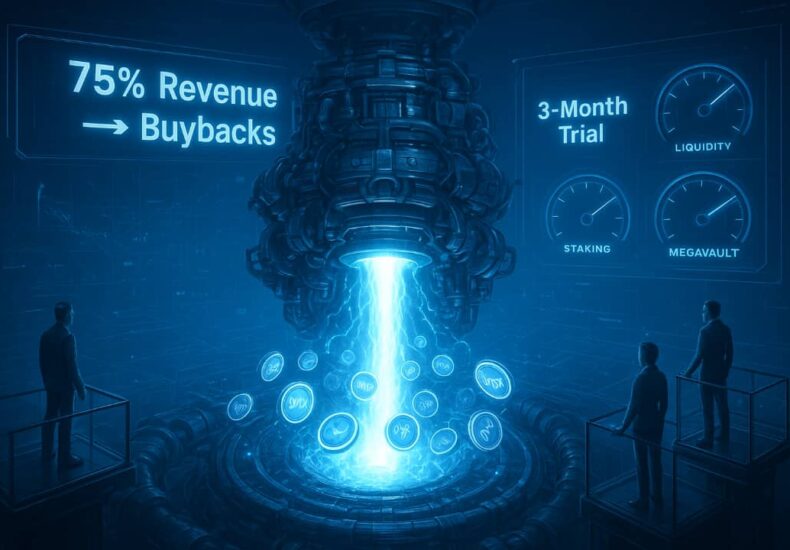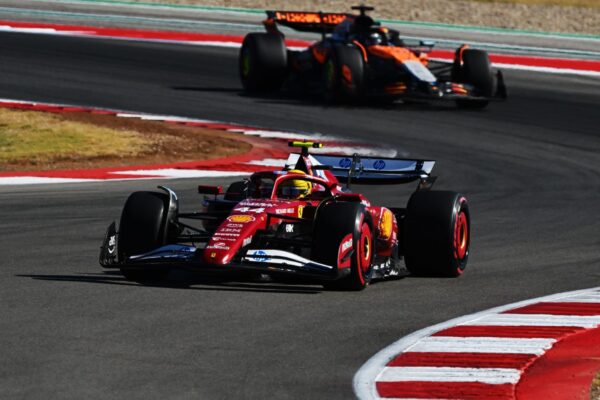
dYdX Community Approves Major Shift: 75% of Protocol Revenue Now Goes to DYDX Buybacks
The dYdX Foundation has confirmed a major change to the protocol’s revenue distribution. Following a community vote, the proposal to allocate 75% of protocol revenue to DYDX buybacks has been officially approved and takes effect immediately. This marks one of the largest redistributions since the chain’s launch.
### A Major Shift in Revenue Allocation
Previously, the protocol operated under a model allocating 25% of revenue to buybacks. The new update triples this allocation to 75%. In practical terms, this means that three out of every four dollars earned through trading fees will now be used to purchase DYDX tokens on the open market.
This change is designed to increase direct buying pressure, tighten token supply over time, and reinforce long-term value for holders. The dYdX Foundation and the protocol’s governance accounts publicly shared the announcement, framing the upgrade as a data-driven correction aimed at improving capital efficiency across the ecosystem.
—
### A Buyback Model Built for Efficiency
The new revenue structure is straightforward. The protocol collects fees from trading activities on dYdX Chain, and now, 75% of those fees flow directly back to the open market to buy back DYDX tokens.
Buybacks are one of the clearest methods to support a token’s value. They:
– Increase constant buy-side liquidity
– Apply steady pressure on token supply
– Reward long-term holders by strengthening the price floor
At current revenue levels, this allocation enables the protocol to repurchase up to approximately 5% of the total DYDX supply annually. Given DYDX’s circulating supply in the hundreds of millions and its status as one of the more liquid governance tokens, this buyback program represents one of the most significant demand drivers in the token’s history.
Importantly, the continuous demand generated by buybacks scales directly with the protocol’s performance, aligning token value with ecosystem growth.
—
### MegaVault Allocation Reduced After 72% TVL Drop
One of the most notable shifts in the proposal is the dramatic reduction of the MegaVault allocation from 25% to just 5%.
The MegaVault was originally designed to incentivize liquidity within the dYdX ecosystem. However, participation has been weak, and the Total Value Locked (TVL) in the MegaVault has dropped by 72% since September. This decline has rendered it less effective as a capital sink or liquidity tool.
Acknowledging this trend, the community has reallocated funds away from the underperforming MegaVault pool toward more efficient strategies, such as buybacks. This realignment marks a shift toward capital deployment focused on utility rather than incentive-heavy liquidity programs.
—
### Staker Allocation Adjusted But Participation Remains Strong
Staker rewards have also been reduced under the new model. Stakers will now receive 15% of protocol revenue, down from their previous share.
Interestingly, this reduction occurs despite rising staking participation. The protocol noted that even after prior reward cuts, the number of users locking up DYDX has increased. This suggests that stakers are less sensitive to annual percentage rate (APR) changes and that governance alignment and long-term positioning remain their primary motivators.
Reducing staker allocation helps free up more revenue for buybacks without destabilizing staking participation—a balance that strengthens governance while enhancing token value strategies.
—
### Treasury SubDAO Funding Tightened to Promote Discipline
The Treasury SubDAO’s allocation will be reduced to 5% of protocol revenue. This adjustment aims to enforce spending discipline while ensuring sufficient resources remain for ecosystem growth and development.
The Treasury SubDAO funds builders, grants, campaigns, and ecosystem expansion. However, the community decided that a 5% allocation is adequate to maintain momentum and avoid unnecessary spending. This cut encourages a leaner treasury operating model at a time when many protocols are prioritizing sustainability-first budgeting.
—
### A Three-Month Trial Phase Begins Now
The new revenue distribution is not yet permanent. The community has approved a three-month trial period to evaluate the impact of these changes.
Over the coming quarter, governance contributors and the dYdX Foundation will monitor:
– Buyback performance and market impact
– Changes to token liquidity
– Staking participation
– MegaVault inflows and outflows
– Treasury burn rates and overall efficiency
– Protocol revenue shifts
Depending on the outcomes, the community may choose to extend or permanently lock in the new model. Alternatively, if any segment underperforms, governance can revisit and adjust the distribution again.
This trial-based approach illustrates dYdX’s broader governance philosophy: test, measure, adapt, and improve.
—
### Strengthening the Token’s Fundamentals
This proposal marks a shift toward fundamentals-first tokenomics. Buybacks provide direct benefits to holders by being:
– Transparent
– Scalable with protocol activity
– Free of dilution or emissions-based mechanics common in other protocols
By dedicating 75% of revenue to buybacks, the protocol aligns incentives around:
– Increased trading volume
– Improved liquidity
– Stronger long-term token value
– A more sustainable revenue model
Meanwhile, reduced allocations to the MegaVault, stakers, and the treasury reflect a system-wide tightening, channeling funds toward strategies with measurable impact.
—
### dYdX Positions Itself for a Stronger Future
Tripling the buyback allocation is a significant milestone for the dYdX ecosystem. It demonstrates a community that is increasingly data-driven, disciplined, and focused on direct value capture.
With 75% of protocol revenue now dedicated to supporting DYDX in the open market, the protocol enters a new phase where performance and token value are fundamentally linked.
The next three months will be critical in determining the effectiveness of this shift. For now, the message is clear: the dYdX community is committed to building a stronger, more sustainable token economy—and this proposal is a decisive step toward that goal.
—
**Disclosure:** This article is for informational purposes only and does not constitute trading or investment advice. Always conduct your own research before buying any cryptocurrency or investing in any related services.
https://themerkle.com/dydx-community-approves-major-shift-75-of-protocol-revenue-now-goes-to-dydx-buybacks/
You may be interested
Globe bets on prepaid fiber, sets expansion
No content was provided to convert. Please provide the text...
Bragging rights up as Samal makes 5150 debut
A stellar Open division field will be shooting for the...
DigiPlus launches P1-M surety bond program
MANILA, Philippines — DigiPlus Interactive Corp. has partnered with Philippine...
 The New York Times
The New York Times
- Pope Leo Doesn’t Want to Be the Anti-Trump. But He Is. 2025 年 11 月 16 日 David French
- Pentagon to Withdraw Some National Guard Troops From Chicago and Portland 2025 年 11 月 16 日 Eric Schmitt
- Homeland Security Missions Falter Amid Focus on Deportations 2025 年 11 月 16 日 Nicholas Nehamas, Michael H. Keller, Alexandra Berzon, Hamed Aleaziz and Zolan Kanno-Youngs
- James Watson Saw the True Form of DNA. Then It Blinded Him. 2025 年 11 月 16 日 Nathaniel Comfort
- Meet Dr. ChatGPT 2025 年 11 月 16 日 Teddy Rosenbluth
- What to Know About Chile’s Election on Sunday 2025 年 11 月 16 日 Emma Bubola and John Bartlett
- Epstein Emails Reveal a Lost New York 2025 年 11 月 16 日 Shawn McCreesh
- A Family Fell for a Rent-A-Bank Scheme. Now They Are Facing Foreclosure. 2025 年 11 月 16 日 Tara Siegel Bernard
- What’s More Dangerous Than India’s Frequent Heat Waves? Heat Stress. 2025 年 11 月 16 日 Anupreeta Das and Anindito Mukherjee
- The N.Y.P.D. Prepares for Mayor Mamdani and a New Era in Public Safety 2025 年 11 月 16 日 Maia Coleman and Maria Cramer



Leave a Reply